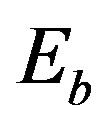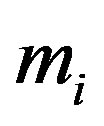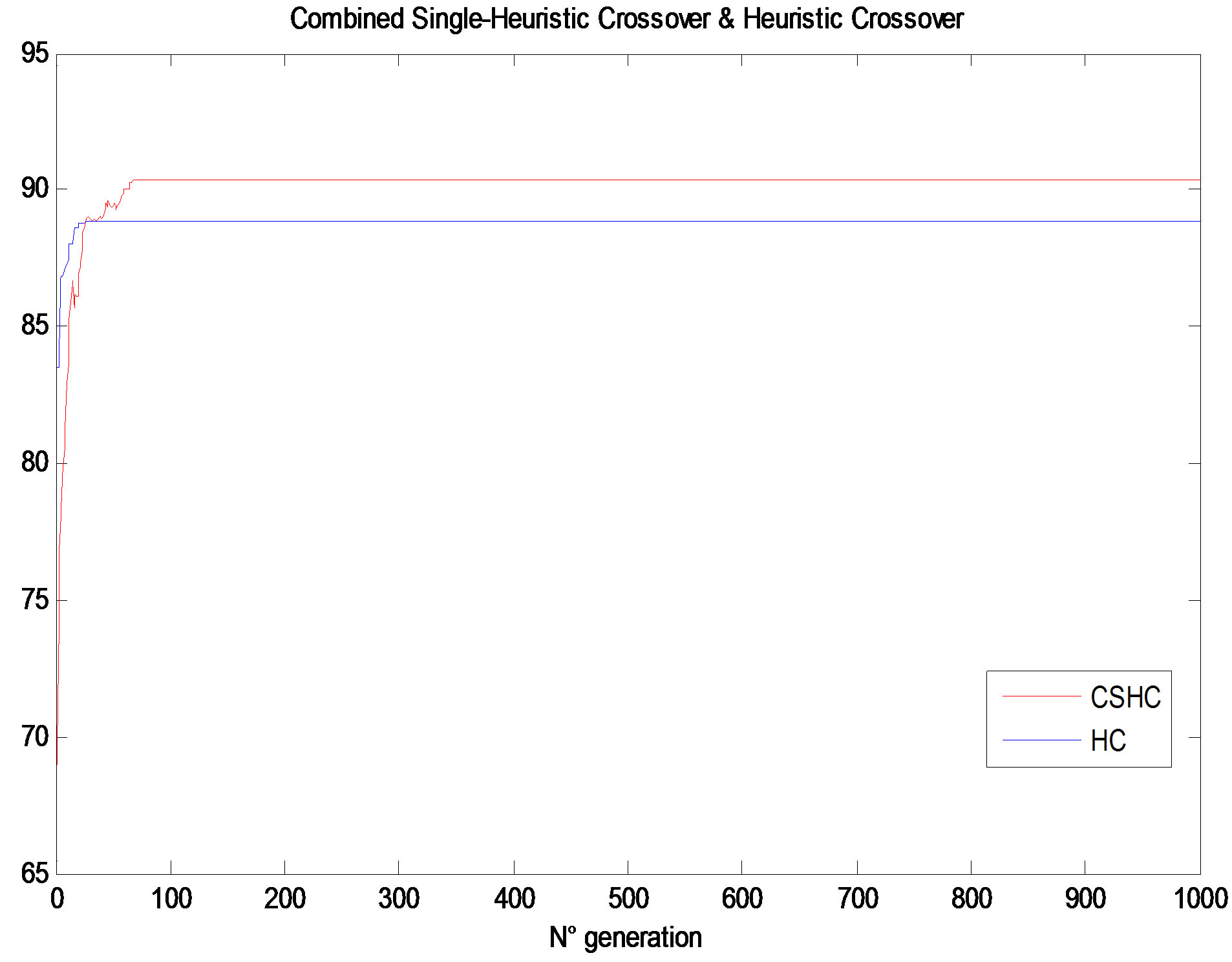Int'l J. of Communications, Network and System Sciences
Vol.6 No.11(2013), Article ID:39721,6 pages DOI:10.4236/ijcns.2013.611050
Optimization of QoS Parameters in Cognitive Radio Using Combination of Two Crossover Methods in Genetic Algorithm
LA2I Lab, Ecole Mohammadia des Ingénieurs (EMI), Mohammed V-Souisi University, Rabat, Morocco
Email: abdrfaoui@gmail.com
Copyright © 2013 Abdelfatah Elarfaoui, Noureddine Elalami. This is an open access article distributed under the Creative Commons Attribution License, which permits unrestricted use, distribution, and reproduction in any medium, provided the original work is properly cited.
Received October 8, 2013; revised November 7, 2013; accepted November 15, 2013
Keywords: cognitive radio; genetic algorithm; spectrum allocation; decision-making; spectrum management; quality of service (QoS); multi-objective; weighted sum approach; heuristic-crossover
ABSTRACT
Radio Cognitive (RC) is the new concept introduced to improve spectrum utilization in wireless communication and present important research field to resolve the spectrum scarcity problem. The powerful ability of CR to change and adapt its transmit parameters according to environmental sensed parameters, makes CR as the leading technology to manage spectrum allocation and respond to QoS provisioning. In this paper, we assume that the radio environment has been sensed and that the SU specifies QoS requirements of the wireless application. We use genetic algorithm (GA) and propose crossover method called Combined Single-Heuristic Crossover. The weighted sum multi-objective approach is used to combine performance objectives functions discussed in this paper and BER approximate formula is considered.
1. Introduction
In the past years, end user became service oriented and the increased demand of wireless applications, has increased the demand of bandwidth which resulted in spectrum scarcity. The efficient use of licensed spectrum becomes a subject of recent contributions [1]. The Federal Communication (FCC) published a report in November 2002, aiming at establishing new spectrum strategies to resolve the overcrowding bands [2] and allowing SU to use licensed bands accordingly. Proposed strategies enable the unlicensed users to use the licensed frequencies simultaneously with the licensed users as long as they conform to environment constraints. Cognitive Radio is one of the leading technologies to answer the spectrum overcrowding problem. CR concepts are based on intelligent modules to measure and sense unused spectrum as well as adapt radio parameters in manner to avoid or limit interference with other users [3]. Artificial intelligence is mostly the best way used to enhance radio learning capabilities from shared environment. Based on collected information, it allows possibilities to exploit empty frequencies in the licensed band of spectrum and can be assigned to SU without causing any interference to other uses.
Results from [4] introduction derived relationship between the transmission and environmental parameters. Moreover, many other researches are based on GA adaptation to increase the performance and the quality of final solution. In [4] population adaptation, the adaptation was proposed. The paper [5] discussed the adaptation of mutation/crossover probabilities based on the evolution of generations.
In this paper, section 2 introduces Cognitive Radio concept, transmission/environmental parameters. Section 3 describes performance objective used in this paper and assumption considered in the model. Section 4 covers the background of GA and the presentation of the proposed crossover method. Section 5 presents simulation and results and Section 6 concludes the paper with introduction of possible future work.
2. Cognitive Radio
2.1. Introduction
Cognitive Radio is firstly used by Mitola and Magurire [6], It’s a smart radio that have ability to change and reconfigure internal parameters according to the radio environment. Secondary User in Cognitive Radio can borrow the unused spectrum for a time interval from the Primary User without causing interference to the Primary Users.
As described in [6], a Cognitive Radio device must have four qualities to achieve optimal spectrum utilization:
• Sensing spectrum.
• Understanding QoS requirements.
• Understanding regulatory policies enforced by the regulator.
• Understanding of radio cognitive internal capabilities.
Cognitive Radio essentially takes advantage of Software Defined Radio (SDR) with artificial intelligence, capable of sensing and reacting to the environment changes. A radio may be able to sense the current spectral environment, and have some memory of past transmitted and received data along with power, bandwidth, modulation, SINR, etc.
From all above, RC takes appropriate decisions about how to optimize the fixed objective.
Possible goals could include:
1) Primary and Secondary Users point of view:• Maximize SINR, data rate, throughput.
• Mitigate interferences.
• Minimize power consumption.
• Minimize BER.
• Maximize Battery life.
• Maximize medium access.
2) Network point of view:• Ensure efficient spectrum utilization.
• Maximize throughput aggregation.
• Ensure appropriate coverage.
• Optimal network capacity.
The main functionality of CR is its capability to perform dynamic optimization of communication parameters and enhance the capability to adapt with brisk environment changes. Many implementations of Genetic algorithms based cognitive radio are tested, but the performance and results of these algorithms depend on the fitness functions model, the number of performance objectives and it can also depend on GA operators. GA is used to optimize multi-objective problems and produce the Pareto Front (the non-dominated solutions in the solution space) which needs decision-making capability to decide accordingly optimal configuration that respect QoS requirements.
2.2. Transmission and Environmental Parameters
Transmission and environmental parameters represent inputs of CR system. Based on those parameters, the quality and accuracy of solution are evaluated. More parameters make the radio system more informed, thus increase the difficulty of the implementation but allowing generating optimal decision.
Two types of parameters are used:
• Environmental parameters include all information about wireless shared environment. Sensor module has to be implemented to collect environmental-sensed data.
• Transmission parameters include all important inputs that are controlled by the system and used for decision. The final decision is the optimal set of transmission parameters that achieves the set of performance objectives.
Table 1 illustrates the transmission and Environmental parameters used in this paper
3. Problem Formulation and Assumptions
In this paper, we assume that inputs are collected from the radio environment (using a sensor) or secondary user. A Cognitive Radio must be including intelligence so that it can detect the spectrum accurately. According to [7], there are possible scenarios for an inaccurate decision, a “false alarm” when there’s no active primary user in the radio environment but the CR observes that there’s a present primary user. And “missed detection” is the opposite of “false alarm”; the CR observes that a PU is not present and the PU is using the spectrum. Both scenarios lead to interferences or missing the opportunity to allocate freer frequencies.
We also suppose that QoS requirements have been specified for each type of application. The purpose of optimization in spectrum allocation is assigning the free frequency spaces in the shared spectrum to the SU. So defining derived fitness function from performance objectives is the key of successful QoS management and result optimal spectrum utilization. Every CR device controls the power to reduce noise and guarantee the required power consumption, also adaptive modulation and coding scheme present important factor to compensate variation in the channel and results satisfied throughput and bit error rate requirements. Carrier frequency must also be

Table 1. Transmission and environmental parameters.
well chosen to prevent any vibration.
The dependence between all parameters and performance objectives made the optimization problem more complex. The quality of optimization solutions will depend on the quality of the algorithm used, algorithm operators, population size, execution time, optimality of solutions, CPU/RAM use, etc. In this paper we have chosen four performance objectives: minimizing power consumption/bit error rate, and maximizing throughput/ spectral efficiency. The genes considered in this paper are listed in table 1, we’ll use values from parameters of CR network as IEEE 802.22 discussed in paper [8]. Each fitness function must be normalized in the same range. So multi-objective weighted sum approach is more appropriate, it allows applying weights to normalized objectives. Weights have been choosing accordingly, and they depend on the QoS required from the end application. Derived fitness function for each parameter is initially used in [4].
The power consumption is the supplied power to maintain device operation, the total fitness include derived and normalized power consumption.
All technologies used in telecommunications have a fixed and important goal, to have free error rate or to minimize the bit error rate of transmission. To calculate the bit error rate, we assume AWGN channel model and using a gray-coded assignment, M-QAM and M-PSK are also considered as the set of Modulation types considered in this paper. Energy per bit  to the noise spectral density
to the noise spectral density  is the second important factor to determine BER.
is the second important factor to determine BER.
 (1)
(1)
Where P transmitted power assuming that no Path Loss is considered, B channel bandwidth, N measured noise power,  symbol rate and
symbol rate and  modulation index. According to the modulation type, we get different formula of BER [9].
modulation index. According to the modulation type, we get different formula of BER [9].
For M-QAM:
 (2)
(2)
For M-PSK:
 (3)
(3)
Most wireless applications require free error rate or minimized BER. Using the approximation [10] and assuming QoS requirement of BER <= 0.001, mi >= 2:
 (4)
(4)
Throughput formula depends on the definition used; it illustrates the amount of information received
 (5)
(5)
where number of sub-carriers.
The spectral efficiency is defined as the amount of information that can be transmitted over a given bandwidth:
 (6)
(6)
The cumulative sum of all performance function with the percentage of required QoS of each KPI is iluustrated using “ ” weight associated to the performance objective “
” weight associated to the performance objective “ ”.
”.
 (7)
(7)
The percentage of Total fitness:
 (8)
(8)
Weights differ according to application modes
4. Genetic Algorithm
GA is robust search and optimization technique inspired from nature [11,12] by mimicking processes nature used to evolve solution to complex optimization problems. GA is adaptive heuristic search based on evolutionary concepts. Even the fact that GA starts with randomized solutions, it exploits historical information to direct search into the space of better performance within the search space. Rechenberg is the first scientist describing the evolutionary computation and John Holland is the inventor of GA, published in 1975 on his book “Adaptation in Natural and Artificial Systems” [13]. Since the invention of GA, It has been solved difficult problems. It’s mainly used for parallelism purpose and the primary advantage is the fact that they work to with a population of solutions. Consolidated with operators, It explores the search space and less likely to get stuck in local extreme According to the same principle as evolutionary concepts, the GA starts with randomized population of solutions, and reproduces new population based on the best fitness. By repeating this cycle several times, ended population will include best solutions. Figure 1" target="_self"> Figure 1 illustrates pseudocode of general scheme of evolutionary process in GA.

Figure 1. Generic pseudo-code for one iteration.
4.1. The Glossary Used in GA Literature
4.1.1. Individual
Individuals are the solutions of the problem to be optimized. All solutions must be coded so that the treatment can be carried out by the genetic algorithm. The encoded representation is called a chromosome, and is composed of genes. Each gene can be a variable, an element of the solution, or a more abstract part. In the most used coding genetic algorithm is the encoding vector. Each solution is represented by a vector. This vector can be binary, integer, real, character, etc... Different types of coding are used, binary coding, gray coding, real and coding tree.
The convergence of GA may need time to obtain an optimal solution but normally do nottake much time to give very good solutions [11]. Bellow we describe words used in GA literature [11-17]
4.1.2. Population
The set of chromosomes is within the same generation. Usually, the size of the population remains constant during GA process
4.1.3. Selection
Depending on individual fitness, each individual is assigned a percentage chance of being selected for reproduction, which is the relative importance of the quality of the individual in relation to the overall quality of the population. Many selection methods are used in GA literature, the most commonly used methods of selecting chromosomes for parents to crossover are Roulette wheel Selection, Tournament selection, Rank selection and other heuristic methods.
4.1.4. Reproduction
Reproduction is usually done by crossing two individuals, which produces two new individuals to be placed in the new population. The two common genetic operators are crossover and mutation:
• Crossover: Each child chromosome receives a percentage of genes from each parent selected in crossover operation. The probability of crossover is almost always greater than 50%. According to this probability, we exchange homologous genes from both chromosomes.
• Mutation: despite lower mutation probability (usually less than 0.1). It plays a very important role. A reproduction using only crossover is a hill-climbing method which is limited by the achievement of local maxima. Indeed, the genes of children are limited by the genes of the parents, and if a gene is not present in the initial population (or it disappears because of reproductions), it will never grow in the offspring. The mutation operator is to circumvent this problem and ensure diversity.
4.1.5. Validity and Consistency
According to the encoding method and its meaning, we must always be sure that the individuals in the population arevalid (feasible solution). Indeed, GA operators could produce solution resulting best fitness, but has no practical meaning when interpreted. We must therefore ensure that the function of creating individuals always creates valid individuals, and genetic operators maintain the validity of treated individuals. This is to maintain the overall consistency of the algorithm.
4.1.6. Termination Criterion:
Generally, a genetic algorithm terminates after a number of generations, but it can also end the execution of the algorithm when a certain condition is reached, such as when the quality of an individual exceeds a certain threshold…
Many types of crossover operators are used in GA literature: One-Point crossover, Two Point, Uniform, Arithmetic and heuristic crossovers.
The Combined Single-Heuristic Crossover (CSHC) used in this paper combines both Single point crossover and the heuristic crossover which uses the fitness values of the two parents’ chromosomes to determine the direction of search [14]:


where rand is random number selected between 0 and 1.
The adaptive heuristics consists of selecting the best child resulted from both heuristic crossover and single point crossover.
Single crossover is the most commonly used in GA, when performing crossover, new child is created with a part from parent 1 and second part from parent 2. Both parent’s part are split randomly. Heuristic crossover uses the adaptation of the parents to generate the new offspring. Based on the fitness values of the two parents, the direction of search is fixed.
The combination of two methods guarantees the exploration and exploitation of space search.
5. Simulation and Results
To evaluate the proposed model, we have tested several GA parameters. The GA initialized with 60 Best chromosomes selected from 100 chromosomes. The GA processes will be iterated 1000 times. Selection remainder, selection roulette and tournament selection were tested. A population of 60 chromosomes is used to evaluate all GA operators. And single point crossover, heuristic crossover are implemented with probability 0.9 and mutation 0.01. Table 2 resumes the values of GA parameters.
One Mode is tested in this paper, throughput mode for applications that need big data and tolerated level of errors.
Evolution of average and max fitness is illustrated in figure 2, it shows the stability of evolution of the mean and best values of fitness. The stability started from the 100th generation.
The figure 3 shows the enhancement of the quality of best solution obtained when combining both single and heuristic crossover The results clearly show the enhancement of obtained fitness value. Our result shows that the best total fitness value turns out to be 90%.

Table 2. GA parameters.

Figure 2. Average and max fitness percentage.

Figure 3. Combined single-heuristic crossover and heuristic crossover.
6. Conclusion
This work shows the flexibility of GA in terms of implementation but also the possibility of adapting and combining operators. It can also be used with other metaheuristic to enhance the quality of solution without penalizing the complexity and time of execution. In this work, we have used four performance objectives, but using more performance objectives will help to approach real model and give more QoS control. The dynamic optimization problem presents another aspect of research, so the future work can be focused on the dynamic optimization and proposing new meta-heuristic fully thought to resolve the spectrum management problem.
REFERENCES
- D. Cabric, S. M. Mishra and R. Brodersen, “Implementation Issues Inspectrum Sensing for Cognitive Radios,” Proceedings of 38th Asilomar Conferences on Signals, Systems and Computers, Pacific Grove, 7-10 November 2004, pp. 772-776.
- Federal Communications Commission, “Spectrum Policy Task Force,” Report of ET Docket 02-135, 2002.
- I. F. Akyildiz, W. Y. Lee, M. C. Vuran and S. Mohanty, “NeXt Generationdynamic Spectrum Access Cognitive Radio Wireless Networks: A Survey,” Computer Networks, Vol. 50, No. 13, 2006, pp. 2127-2159 http://dx.doi.org/10.1016/j.comnet.2006.05.001
- T. R. Newman, R. Rajbanshi, A. M. Wyglinski, J. B. Evans and G. J. Minden, “Population Adaptationfor Genetic Algorithm-Based Cognitive Radios,” IEEE Proceedings of Cognitive Radio Oriented Wireless Networks and Communications, Orlando, 1-3 August 2007, pp. 279-284.
- M. J. Kaur, M. Uddin and H. K. Verma, “Optimization of QoS Parameters in Cognitive Radio Using Adaptive Genetic Algorithm,” International Journal of Next-Generation Networks (IJNGN), Vol. 4, No. 2, 2012, 15 Pages.
- J. Mitola III., “Software Radios: Survey, Critical Evaluation and Future Directions,” Aerospace and Electronic Systems Magazine (IEEE), Vol. 8, No. 4, 1993, pp. 25-36. http://dx.doi.org/10.1109/62.210638
- L. Doyle, “Essentials of Cognitive Radio,” Cambridge University Press, New York, 2009. http://dx.doi.org/10.1017/CBO9780511576577
- V. Blaschke, T. Renk and F. K. Jondral, “A Cognitive Radio Receiver Supporting Wide-BandSensing,” IEEE International Conference on Communications Workshops, Beijing, 19-23 May 2008, pp. 499 - 503.
- J. G. Proakis, “Digital Communications,” 4th Edition, McGraw-Hill, Boston, 2000.
- S. T. Chung and A. J. Goldsmith, “Degrees of Freedom in Adaptive Modulation: A Unified View,” IEEE Transactions on Communications, Vol. 49, No. 9, 2001, pp. 1561- 1571. http://dx.doi.org/10.1109/26.950343
- D. E. Goldberg, “Genetic Algorithms in Search, Optimization & Machine Learning,” Addison Wesley, Boston, 1989.
- T. P. Hoehn and C. C. Pettey, “Parental and Cyclic-Rate Mutation in Genetic Algorithms: An Initial Investigation,” Proceedings of Genetic and Evolutionary Computation Conference, Orlando, 1999, pp. 297-304.
- J. H. Holland, “Adaptation in Natural and Artificial Systems,” University of Michigan Press, Ann Arbor, 1975.
- F. Herrera, M. Lozano and A. M. Sánchez, “A Taxonomy for the Crossover Operator for Real-Coded Genetic Algorithms. An Experimental Study,” International Journal of Intelligent Systems, Vol. 18, No. 3, 2003, pp. 309-338. http://dx.doi.org/10.1002/int.10091
- G. F. Luger, “Atrificial Intelligence: Structures & Strategies for Complex Problem Solving,” 4th Edition, Addison-Wesley, Boston, 2002, 856 Pages.
- M. Negnevitsky, “Artificial Intelligence: A Guide to Intelligent Systems,” Addison-Wesley, Boston, 2002, 394 Pages.
- http://www.genetic-programming.org/

